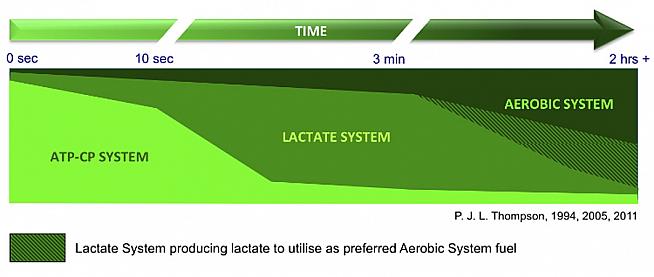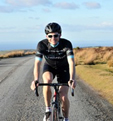Are you confused by heart rate zones? If so you shouldn't be surprised, because I reckon that there are something like 80 different ways to calculate and present them. I am now working with a lot of cyclists every week and the general state of play is that people know that they should be training in specific zones, but quite a few people have not made the leap yet, and out of those that have I doubt whether many people could answer the question - Why?
So why do we train in different zones? The easiest way to explain this in a relatively non sciencey way, and then be able to use the zones practically, is to gain an understanding of our different energy systems.
As you exercise, your working muscles require a constant supply of energy. In order to satisfy this need the body relies upon three energy systems that work seamlessly together to turn the fuel that we eat into the watts that we produce to turn the pedals. Fundamental to all training zone theory is a clear understanding of these systems.
The three main energy systems are Aerobic, Lactate and Anaerobic (ATP-CP). Although you use different proportions of these systems at any one time, they are all working in harmony at any level of exercise intensity.

Aerobic
Think of the aerobic system as your body's diesel engine. It is a system that produces energy through the combustion of carbohydrate and fat in the presence of oxygen. It is only able to produce a relatively small amount of energy, so cannot produce enough energy for sprinting, but can produce power for extended periods of time, making it the predominant system used during any endurance ride. The major aerobic fuel supply is fat which is stored in abundance in the body. Training your body to use more fat as fuel is the most important thing you can do to improve as an endurance cyclist.
Lactate
As the intensity of your cycling increases you start to utilise more of your lactate energy system and less of your aerobic system. This system breaks down carbohydrate, a fuel in limited supply in the body, to produce medium amounts of power for medium amounts of time. The lactate system's use of carbohydrate is significant. The body stores carbohydrate in the form of glycogen in the muscles and liver. However, these stores only equate to about 2000 calories worth of energy, which can be completely exhausted in as little as 90 minutes when exercising at a higher intensity.
Anaerobic
Both the aerobic and lactate energy systems utilise oxygen to greater or lesser degrees to produce energy. Our anaerobic energy system can operate without oxygen for very short periods of time. Have you ever wondered why when you start sprinting the first 10-15 seconds feel almost effortless? During these short, high power bursts the body has to rely on a fuel that can provide energy instantaneously. The anaerobic energy system has the capacity to produce vast quantities of energy very quickly, but because it does not use oxygen it can't produce that energy for very long. Think of it as a turbo charger in a car.
To be a good all round cyclist you need to develop all three of these energy systems. We develop our aerobic system so that we can cycle further. We develop our lactate system so that we can cycle faster. We develop our anaerobic system so that we we can make it over that 25% hill summit!
I use a 5 zone heart rate system. As I said at the beginning, there are a plethora of ways to set and then calculate heart rate zones. I like 5 because it is less than 7 and normally in life simple is better than complex.

Using our newly acquired understanding of the energy systems we can now map these into the 5 heart rate training zones.
Z1 and Z2 is where you develop and improve your aerobic energy system. This level of exercise should feel easy and comfortable - you should be able to hold a conversation, which makes these training rides a great social outing if you are with friends. You should be able to ride all day at this intensity as long as you fuel.
Z3 and Z4 is where you develop and improve your lactate energy system. This level of exercise will require more and more concentration to keep going. At the lower level of Z3 you will start to breath more deeply but you should still be able to train yourself to ride for a couple of hours at this level of intensity.
As you move into the boundary of Z3 and Z4 (often referred to as the Sweet Spot) you will have to focus more to keep the effort level sustained. By the time you reach the upper level of Z4 you will be close to the red line and might be able to utter a few single words. You might be able to keep this level of intensity up for 30 minutes max.
Z5 is where things start to become more and more anaerobic. You will know when you are there even without looking at your heart rate monitor. You will be losing control of your regular breathing pattern and you wont be able to talk apart from maybe the odd whimper! If you are really fit you might be able to keep the lower level of Z5 intensity up for 8 minutes or so. If you push harder to near your max heart rate then the amount of time you can sustain these efforts for reduces exponentially.
All of the Propello Training Programmes look to develop the three energy systems in a systematic way. We start by building our diesel engine, training mainly in Z2 and improving technique and strength. We then move onto developing speed, improving our lactate energy system starting with Z3 and gradually increasing intensity. Training in Z3-Z4 pushes our fitness up - we then introduce some anaerobic training in Z5 which pulls fitness up. This combination of pushing and pulling is highly effective at improving our speed and muscular endurance.
Hopefully you will have a better understanding of why we use training zones and how they relate to the different energy systems that you need to develop to become a good all round cyclist. As ever I try to explain these scientifically complex areas as clearly as possible - if you have any questions please feel free to contact me.
Rob Wakefield is a fully qualified Level 3 Cycling Coach with the Association of British Cycling Coaches and founder of Propello, a cycling focused health and fitness business delivering Performance Training Programmes and Bespoke Coaching to cyclists anywhere in the world.
All cyclists who are looking to improve their speed, endurance or strength will benefit from a structured training programme. Propello Training will improve how your muscles, lungs and heart work and will enable your body to transport and utilise fuel effectively - making you faster and stronger for longer.
Click here to learn more about Propello.
0 Comments





